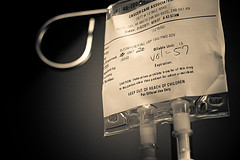
Could it be that a chemical used in treating cancer could also cause cancer? According to the latest list of toxic chemicals released by the state of California, amsacrine, a chemotherapy drug, is also a carcinogen.
A drug used in the treatment of acute adult leukemia, amsacrine (Amsidine®) was found to cause tumors in Wistar rats, according to a study by Graziano M.J. and colleagues, with tumors showing up on the skin and in the uterus, small intestine, mammary gland, and thymus. According to Dr. Zuck of healthline.com, the drug is no longer commercially available in the U.S., but still is in Canada.
Another surprise? Bleomycins-antiobiotics used in chemotherapy treatments-are also listed as carcinogens. Bleomycins, according to cancer.org, are antibiotics used to treat testicular cancer, lymphoma, and cancer of the head, neck, cervix, and other sites. The drug works by interfering with cell division. Nothing is listed in the side effects that indicates “carcinogen,” but some studies have shown tumor activity in rats. According to drugs.com, “The carcinogenic potential of Bleomycin in humans is unknown,” but “…Bleomycin has been shown to be mutagenic both in vitro and in vivo.”
Toluene-a chemical we told you about in an earlier post that’s found in some fingernail polish-also made the list as potentially harmful to the female reproductive system. Most of the other chemicals are those you’d probably suspect of being unhealthy, like those used in antifreeze, gasoline, paint, plastic, and foam products. However, a couple more were concerning, like those used in household pesticides and garden weedkillers, and those listed as HIV drugs.
If you’re finding any of these chemicals in your life, get rid of them if you can, or-as in the case of the drugs-ask your doctor. We’ve copied the complete list of chemicals below.
Male Reproductive Toxicants
- n-Butyl glycidyl ether: used to make epoxy resins with a number of uses in common products
- Carbaryl: a household pesticide used to kill a range of insects, and sold as Sevin by GardenTech and Bayer (also a developmental toxicant)
- 2-Chloropropionic acid: a chemical used to make herbicides
- Dichloroacetic acid: which forms in drinking water as a byproduct of disinfection using chlorine
- Diglycidyl ether: a chemical used to make epoxy resins
- Ethylene oxide: a chemical mainly used in the manufacturing of chemicals like antifreeze and polyester
- Ethyl-tert-butyl ether: a common gasoline additive
- Methyl chloride: a chemical used primarily to make silicone polymers, but also used in other processes, including the oil refining
- Methyl n-butyl ketone: an industrial solvent
- Phenyl glycidyl ether: an industrial chemical
- 1,3,5-Triglycidyl-s-triazinetrione: a constituent of some paints
- 4-Vinyl-cyclohexene: a chemical used in the production of epoxy resins
Carcinogens
- Amsacrine: a chemotherapy drug
- Bleomycins: antibiotics used in chemotherapy treatments
- Chlorophenoxy herbicides: including 2,4-D, are common weedkillers sold for lawn & garden use
- Marine diesel fuel
- Progestins: synthetic hormones found in some birth controls
- Styrene: an ingredient in many plastic and foam products
- Toxins derived from Fusarium moniliforme (Fusarium verticillioides): a fungus
- Vinyl acetate: a compound used to make polymers used in plastics, films, lacquers, adhesives, inks, water-based emulsion paints, floor tiling, safety glasses, cosmetics and personal-care products
- Wood dust
- Zalcitabine: an HIV drug sold as Hivid
- Zidovudine (AZT): an HIV drug
Developmental Toxicants
- Tert-Amyl methyl ether: a common fuel additive
- Carbaryl: a household pesticide used to kill a range of insects, and sold as Sevin by GardenTech and Bayer
- Chloroform: used in the manufacturing of other chemicals; can form in drinking water as a byproduct of disinfection using chlorine
- N,N-dimethylacetamide: a solvent used in industries ranging from fibers and adhesives to pharmaceuticals and plasticizers
- Ethylene oxide; a chemical mainly used in the manufacturing of chemicals like antifreeze and polyester
- 2-Ethylhexanoic acid: a chemical associated with phthalates and PVC plastics
- p,p’-Oxybis (benzenesulfonyl hydrazide): an industrial chemical
- Phenylphosphine: an industrial chemical
Female Reproductive Toxicants
- Toluene: a constituent of oil, is found in gasoline and is used to make paints, paint thinners, fingernail polish, lacquers, adhesives and rubber
- 4-Vinyl-cyclohexene: a chemical used in the production of epoxy resins
Have you had any negative experiences with these chemicals? Please share your story.
Photo courtesy of lindsey yeo via Flickr.com.

